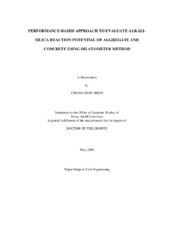| dc.description.abstract | The undesirable expansion of concrete because of a reaction between alkalis and certain type of reactive siliceous aggregates, known as alkali-silica reactivity (ASR), continues to be a major problem across the entire world. The renewed interest to minimize distress resulting from ASR has emphasized the need to develop predictable modeling of concrete ASR behavior under field conditions. Current test methods are either incapable or need long testing periods in which to only offer rather limited predictive estimates of ASR behavior in a narrow and impractical band of field conditions. Therefore, an attempt has been made to formulate a robust performance approach based upon basic properties of aggregate and concrete ASR materials derived from dilatometry and a kinetic-based mathematical expressions for ASR behavior. Because ASR is largely an alkali as well as a thermally activated process, the use of rate theory (an Arrhenius relationship between temperature and the alkali solution concentration) on the dilatometer time-expansion relationship, provides a fundamental aggregate ASR material property known as “activation energy.” Activation energy is an indicator of aggregate reactivity which is a function of alkalinity, particle size, crystallinity, calcium concentration, and others. The studied concrete ASR material properties represent a combined effects of mixture related properties (e.g., water-cementitious ratio, porosity, presence of supplementary cementitious materials, etc.) and maturity. Therefore, the proposed performance-based approach provides a direct accountability for a variety of factors that affect ASR, such as aggregate reactivity (activation energy), temperature, moisture, calcium concentration, solution alkalinity, and water-cementitious material ratio. Based on the experimental results, the following conclusion can be drawn concerning the performance-based approach to evaluate ASR potential of aggregate and concrete using dilatometer method; (i) the concept of activation energy can be used to represent the reactivity of aggregate subjected to ASR, (ii) the activation energy depends on the reactivity of aggregate and phenomenological alkalinity of test solution, and (iii) The proposed performance-based model provides a means to predict ASR expansion development in concrete. | en |


